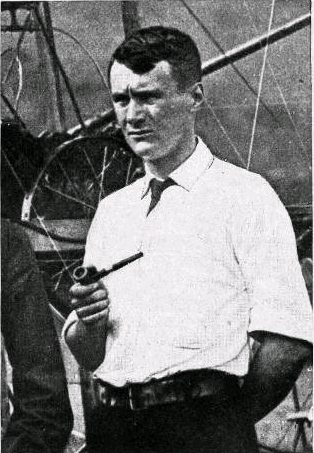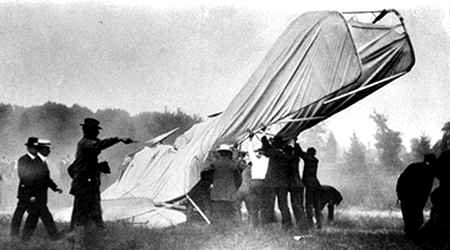Thomas Selfridge
Today, the first powered aviation fatality. The University of Houston presents this series about the machines that make our civilization run, and the people whose ingenuity created them.
Most everyone has heard of the Wright Brothers, but far fewer recognize the name Thomas Etholen Selfridge. Selfridge graduated from West Point in 1903, the same year as the Wright Brother's first flight at Kittyhawk. Soon after, Selfridge himself developed an interest in the burgeoning world of human flight. He was a member of the Aerial Experiment Association, chaired by Alexander Graham Bell, and designed the Association's first powered aircraft, the Red Wing. He piloted two of the Association's aircraft, White Wing and June Bug. In doing so he became the first US soldier to pilot a powered aircraft. The US Army trained Selfridge as a dirigible pilot. When the Army agreed to purchase a Wright Flyer (for testing), Selfridge was appointed to observe and participate in the acceptance flights.
 On a September morning in 1908 at Fort Meyers, Virginia, Selfridge won the dubious distinction of becoming the first to die in a powered aircraft. Selfridge was flying as a passenger, with Orville Wright as the pilot, during a demonstration flight around the fort. All was going well until a propeller split, triggering a chain of events that ended in tragedy. The propeller severed a guy wire supporting a vertical rudder, which fell out of place as the propeller further shattered. As Orville shut down the engine and struggled for control, the craft nosedived about 75 feet into the ground. Orville was badly injured, but would recover and fly again. Selfridge fractured his skull and perished a few hours later.
On a September morning in 1908 at Fort Meyers, Virginia, Selfridge won the dubious distinction of becoming the first to die in a powered aircraft. Selfridge was flying as a passenger, with Orville Wright as the pilot, during a demonstration flight around the fort. All was going well until a propeller split, triggering a chain of events that ended in tragedy. The propeller severed a guy wire supporting a vertical rudder, which fell out of place as the propeller further shattered. As Orville shut down the engine and struggled for control, the craft nosedived about 75 feet into the ground. Orville was badly injured, but would recover and fly again. Selfridge fractured his skull and perished a few hours later.
It is amazing really that the first fatality occurred 5 years following the beginning of powered flight; not because of the volume of flight time accumulated, but due to the primitive state of aircraft control. There had certainly been some bumps — a high percentage of test flights ended in crashes — yet the loss of Selfridge before a crowd of spectators took many off guard.
In spite of this tragedy, the potential of aeroplanes was clear and engaging; aviation development would of course continue. The Wright Brothers determined that stress fractures caused the propeller failure, and redesigned the Wright Flyer. The Army mandated the use of head gear resembling football helmets for its aviators. I would like to report that each mishap resulted in design changes that precluded repeat accidents. The reality is that lessons often had to be repeated several times before risks were effectively designed out of successive aircraft. Many young airmen were killed in the Wright Flyer and other early aircraft before basic, fatal design flaws were recognized and abandoned.

Crashed Wright Flyer that took the life of Selfridge
So what cements Selfridge's place in history? It is not that he died more heroically than those who followed. His death awakened the sensibilities of a public, giddy with the newness of flight, that this was a dangerous business. There were forces to be respected, and operator safety must be added to design wherever possible. Accidents are harsh teachers, but we must act upon their hard won lessons. Arguably, we progress much more upon our failures than our successes. James Russell Lowell's words are appropriate: 'Mishaps are like knives that either serve us or cut us as we grasp them by the blade or the handle.'
I'm Michael Barratt for the University of Houston, where we're interested in the way inventive minds work.
End Notes:
Every practitioner of aviation medicine knows the name of Thomas Selfridge and the basic circumstances of his demise in 1908. There had certainly been systematic considerations of transportation safety before then, primarily relating to sea travel and railroads. But the idea of navigating in three dimensions, and of course the newness of flight, made this a novel and high profile event. The systematic approach to investigating an aviation mishap and using this information to prevent similar future events was essentially born with Selfridge's death. The harsh facts are that Selfridge was the first of thousands of people to be lost in aviation mishaps, and that we continue to see fatal accidents today that can sometimes be traced to basic design flaws in contemporary aircraft. We continually demand greater capabilities in speed, size, and efficiencies, which require increasingly complex solutions and greater difficulties in predicting all outcomes.
Happily, aviation is one aspect of our technology that we have gotten quite good at. The global civil air transportation system is really something of a marvel. Aircraft mishaps of course remain high profile tragedies. However when one considers other methods of moving people such distances, and compares our current risk numbers with the horrific mortality rates of the early years of aviation, it is obvious that we have come a long way. When a mishap does occur, there is an expectation that it will be thoroughly investigated and understood, and every measure taken to prevent its recurrence. For this we owe a debt of gratitude to Thomas Selfridge and many others who have been lost since.
References:
There are a few texts on Aviation Safety and Aviation Medicine as well as several web resources that mention Selfridge. Some of these contain Orville Wright's written description of the events of the first fatal accident. One of the most remarkable sources is the Arlington National Cemetery's web site dedicated to Selfridge; he is buried there — ironically not far from the crash site. Along with a description of the accident, there are some remarkable photographs of the event. Following this are the formal accident reports submitted by the US Army Signal Corps and several press commentaries, all most fascinating reading!
See the excellent Wikipedia articles on Thomas Etholen Selfridge, the Aerial Experiment Association , and Alexander Graham Bell (See the section on Aeronautics).
All images are from Wikipedia.